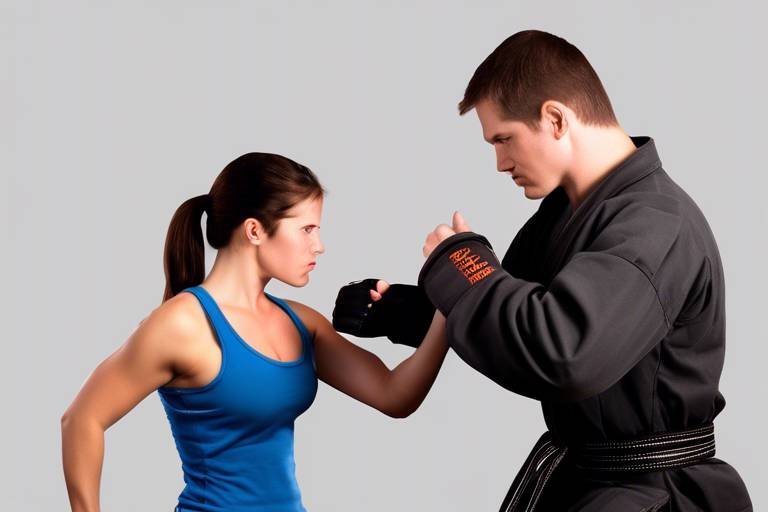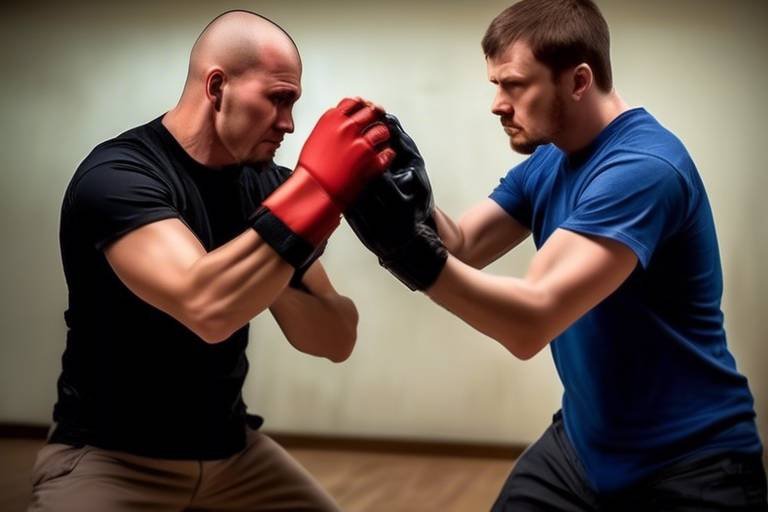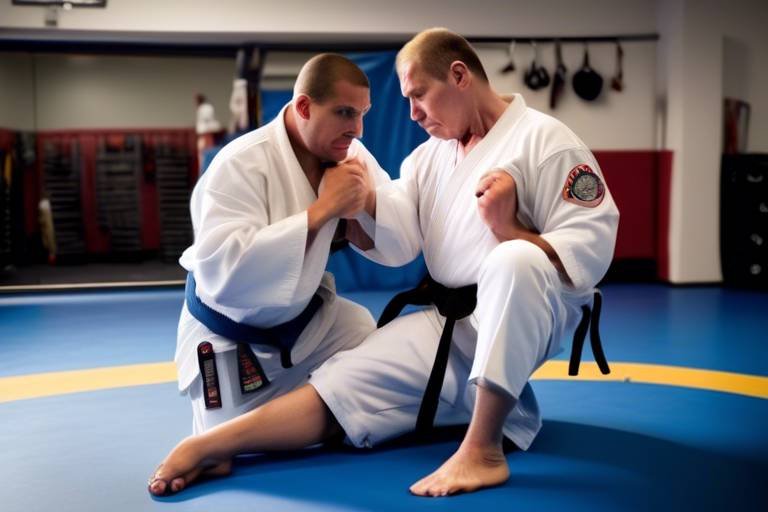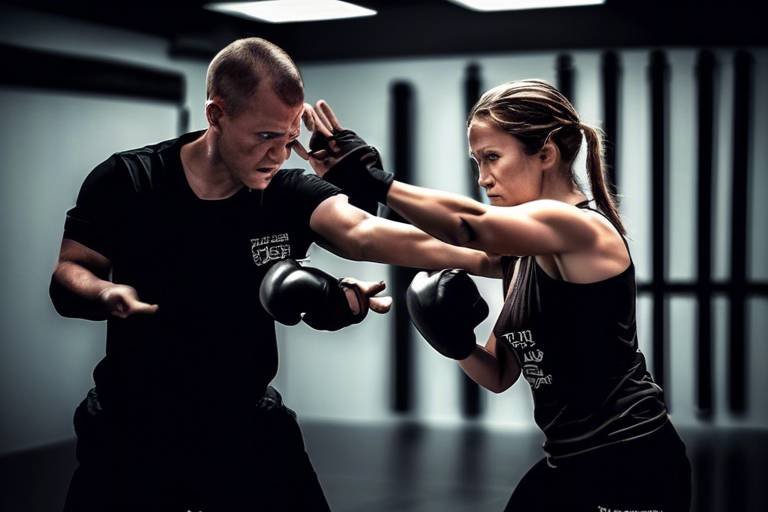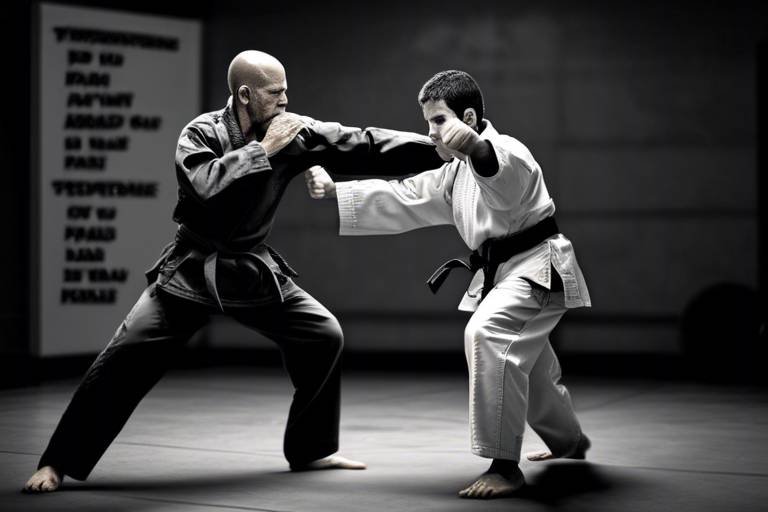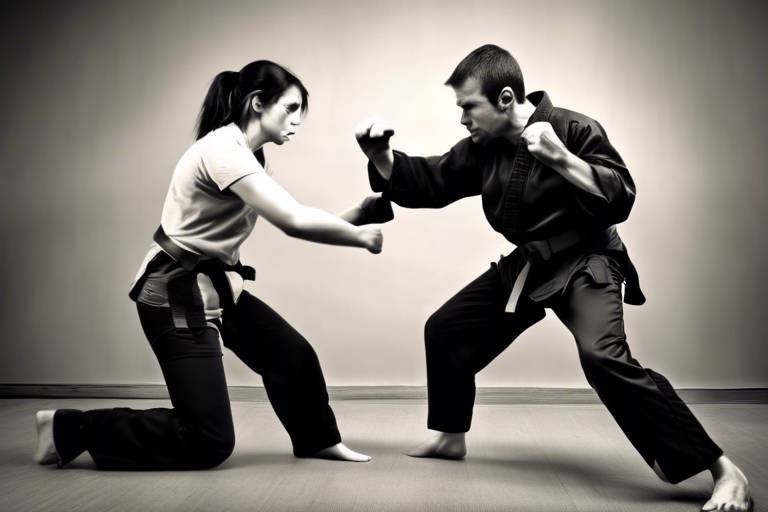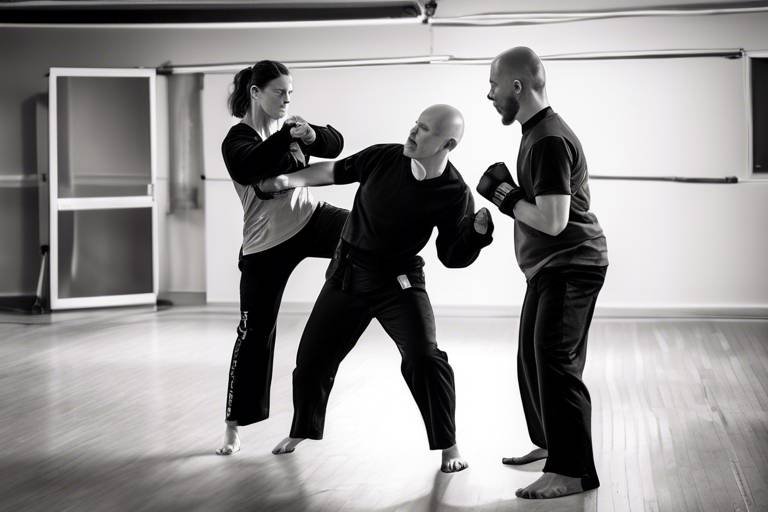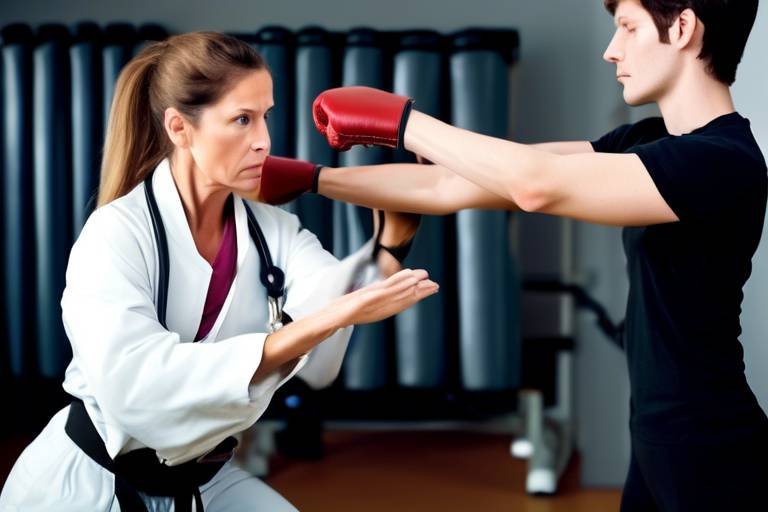How to Physically Prepare for Your First Self-Defense Training Class?
Are you gearing up for your very first self-defense training class? That’s fantastic! Self-defense is not just about learning to throw punches or execute fancy kicks; it’s about building confidence, awareness, and the ability to protect yourself in challenging situations. However, before you step onto the mat, it's essential to prepare your body physically. Think of it as tuning up a car before a long road trip—you want to make sure everything is running smoothly so you can enjoy the ride without any hiccups.
In this article, we’ll explore some key strategies to help you get physically ready for your self-defense training. From understanding the basics of self-defense to assessing your fitness level, we’ll cover everything you need to know. So, let’s dive in and get you prepped and pumped for your first class!
Before you even lace up your training shoes, it’s crucial to grasp the fundamental principles of self-defense. This includes being aware of your surroundings, knowing how to avoid dangerous situations, and recognizing the importance of physical fitness. Self-defense isn’t just about fighting; it’s about **awareness** and **avoidance**. Think of it like being a ninja—you don’t want to engage unless absolutely necessary. By understanding these basics, you’ll set a strong foundation for your training journey.
Now that you have a grasp of the basics, it’s time to assess your current fitness level. This step is crucial because it helps you identify areas that may need improvement. Are you winded after a short jog? Can you do a single push-up? No worries! Everyone starts somewhere. By evaluating your fitness, you can tailor your preparation to meet the demands of self-defense training. Remember, it’s not about being the best; it’s about being better than you were yesterday.
One of the most important aspects of self-defense training is **cardiovascular endurance**. Imagine being in a high-pressure situation where your heart is racing, and your body needs to respond quickly. Building your endurance will help you maintain stamina during intense classes. You can improve your cardiovascular fitness through activities like running, cycling, or even brisk walking. Aim for at least 30 minutes of cardio exercise a few times a week to get your heart pumping!
Incorporating **strength training** into your routine is another key component. Think of it as building the armor that protects you. Strong muscles are essential for executing techniques and defending against potential threats. You don’t need to lift heavy weights; bodyweight exercises like push-ups, squats, and planks can do wonders. Aim to include strength training at least two to three times a week, focusing on all major muscle groups.
Flexibility and mobility are often overlooked but play a vital role in self-defense. Improving these areas reduces the risk of injury and enhances your ability to perform various techniques with ease. It’s like oiling the hinges of a door; everything moves smoother when you’re flexible!
Before your training sessions, consider incorporating **dynamic stretching**. This type of stretching prepares your muscles for action by increasing blood flow and improving your range of motion. Think of it as warming up your engine before hitting the road. Some great dynamic stretches include leg swings, arm circles, and hip openers.
On the flip side, **static stretching** post-training is equally important. This helps in recovery and maintaining flexibility. After an intense session, your muscles need a little TLC. Stretching those muscles can prevent stiffness and keep you agile for future classes. Incorporate static stretches like hamstring stretches, quadriceps stretches, and shoulder stretches to your cooldown routine.
Let’s talk about something that fuels your body: **nutrition and hydration**. Proper nutrition plays a significant role in your physical preparation, providing the energy and nutrients necessary for optimal performance during self-defense training. Think of your body as a high-performance vehicle; you wouldn’t fill it with low-grade fuel, right?
Before your training sessions, consuming balanced meals is essential. This fuels your body and enhances focus and energy levels when practicing techniques. Aim for meals that include a mix of carbohydrates, proteins, and healthy fats. For example, a banana with peanut butter or a small chicken salad can do wonders for your energy levels.
Staying hydrated is crucial for peak performance. Dehydration can lead to fatigue, dizziness, and decreased concentration. Make it a habit to drink water throughout the day, and consider carrying a water bottle to your training sessions. A good rule of thumb is to drink at least 8-10 glasses of water daily, but you may need more if you’re sweating it out in training.
- How fit do I need to be to start self-defense training?
You don’t need to be a fitness guru! Just be willing to learn and improve. - Can I train if I have previous injuries?
Always consult with a medical professional before starting any new training program. - What should I wear to my first class?
Comfortable athletic wear that allows for movement is ideal. - How often should I train?
Aim for at least 2-3 times a week to see progress.

Understanding Self-Defense Basics
This article provides essential tips and insights on how to prepare your body for self-defense training, ensuring you maximize your learning experience and stay safe during practice.
Before diving headfirst into the world of self-defense, it’s crucial to grasp the fundamental principles that lay the groundwork for effective training. Self-defense isn't just about throwing punches or executing fancy moves; it's about understanding your environment and knowing how to protect yourself when necessary. At the core of self-defense are three key concepts: awareness, avoidance, and physical fitness.
Awareness is your first line of defense. Imagine walking through a crowded street; being aware of your surroundings can make all the difference. It’s about noticing the people around you, identifying potential threats, and being alert to unusual behavior. This heightened state of awareness can help you avoid dangerous situations before they escalate. Think of it as having a sixth sense—your intuition is often your best ally in staying safe.
Next comes avoidance. This principle emphasizes the importance of steering clear of confrontations whenever possible. Self-defense isn’t about being a hero; it’s about knowing when to walk away. For instance, if you find yourself in a heated argument, recognizing the signs and choosing to disengage can prevent a situation from turning physical. Avoidance is your shield, protecting you from unnecessary risks.
Lastly, let's talk about the role of physical fitness in self-defense. Being physically fit not only enhances your ability to execute techniques but also boosts your confidence. You wouldn't want to be caught off guard, feeling winded and weak when your body needs to respond. Therefore, incorporating a fitness routine that focuses on cardiovascular endurance, strength training, and flexibility is essential. Think of your body as a finely tuned machine; the better you maintain it, the more effectively it will perform under pressure.
In summary, understanding these basic principles of self-defense will not only prepare you mentally but also physically for your training. Remember, self-defense is as much about mental preparedness as it is about physical capability. By honing your awareness, practicing avoidance, and improving your fitness, you set yourself up for success in your self-defense journey. So, are you ready to take the plunge and equip yourself with the skills to protect yourself?
Evaluating your current fitness level helps identify areas for improvement, allowing you to tailor your preparation to meet the demands of self-defense training.
Building cardiovascular endurance is essential for maintaining stamina during intense self-defense classes, enabling you to respond effectively in high-pressure situations.
Incorporating strength training into your routine enhances muscle power, which is vital for executing techniques and defending against potential threats.
Improving flexibility and mobility reduces the risk of injury and enhances your ability to perform various self-defense techniques with greater ease and efficiency.
Dynamic stretching prepares your muscles for action, increasing blood flow and improving range of motion before training sessions.
Static stretching post-training aids recovery and helps maintain flexibility, ensuring your body remains agile for future classes.
Proper nutrition and hydration play a significant role in your physical preparation, providing the energy and nutrients necessary for optimal performance during self-defense training.
Consuming balanced meals before training sessions fuels your body, enhancing focus and energy levels when practicing techniques.
Staying hydrated is crucial for peak performance; understanding effective hydration strategies ensures you maintain energy and concentration throughout your training.
- What should I wear to my first self-defense class? It's best to wear comfortable athletic clothing and sturdy shoes that allow for movement.
- Do I need any special equipment? Most classes provide equipment, but a water bottle and a towel are always good to have on hand.
- How long does a typical self-defense class last? Classes can range from one hour to two hours, depending on the program.
- Is self-defense training suitable for everyone? Yes! Self-defense training can be beneficial for individuals of all ages and fitness levels.

Assessing Your Current Fitness Level
Before diving headfirst into self-defense training, it's essential to take a step back and assess your current fitness level. Think of it as a roadmap; without knowing where you are, how can you figure out where to go? Understanding your physical capabilities not only helps you tailor your training but also sets realistic expectations for your progress. So, grab a notebook and a pen, because this is where the magic begins!
Start by evaluating different components of your fitness. Consider aspects such as cardiovascular endurance, muscle strength, and flexibility. Each of these elements plays a crucial role in your overall ability to perform self-defense techniques effectively. For instance, cardiovascular endurance is vital for sustaining energy during intense drills, while strength is necessary for executing powerful moves. Flexibility aids in preventing injuries, allowing you to move freely and efficiently.
To assess these areas, you can perform a few simple tests. For cardiovascular endurance, try a 1-mile run or a 3-minute step test. For strength, consider doing a push-up test or a squat test. And for flexibility, a simple sit-and-reach test can give you a good insight into your current state. Here’s a quick overview of these tests:
| Fitness Component | Test | How to Perform |
|---|---|---|
| Cardiovascular Endurance | 1-Mile Run | Run as fast as you can for one mile. |
| Muscle Strength | Push-Up Test | Perform as many push-ups as you can in one minute. |
| Flexibility | Sit-and-Reach Test | Sit on the floor and reach for your toes, measuring how far you can go. |
Once you've completed these assessments, take a moment to reflect on the results. Are there areas where you excel? Maybe you crushed the push-up test but struggled with flexibility. That’s perfectly okay! The key is to identify your strengths and weaknesses so you can create a balanced training plan that addresses all aspects of your fitness.
Moreover, don't hesitate to consult with a fitness professional or a personal trainer. They can provide valuable insights and help you interpret your results. They might even suggest specific exercises or routines tailored to your needs, ensuring that you’re not just training hard but training smart!
In conclusion, assessing your current fitness level is not just a one-time activity; it's a vital part of your self-defense journey. Regularly checking in on your progress allows you to adjust your training as needed, keeping you on track and motivated. Remember, every journey begins with a single step, and knowing where you stand is the first step towards becoming a more capable and confident individual.

Cardiovascular Endurance
When it comes to self-defense training, is your best friend. Imagine being in a high-pressure situation where your heart is racing, and every second counts. If you're not physically prepared, you might find yourself gasping for breath instead of executing those crucial self-defense techniques. That's why building your cardiovascular fitness is not just a suggestion; it's a necessity!
So, what exactly does cardiovascular endurance entail? It's all about your heart and lungs working efficiently together to supply oxygen to your muscles during prolonged physical activity. Whether you're dodging an attacker or executing a swift kick, having a solid cardiovascular base means you'll be able to sustain your energy levels and maintain focus. Think of it as the fuel that keeps your engine running smoothly.
To effectively enhance your cardiovascular endurance, consider incorporating a variety of exercises into your routine. Here are a few effective options:
- Running: A classic choice that boosts your heart rate and builds stamina.
- Cycling: Whether on a stationary bike or outdoors, cycling is excellent for endurance.
- Swimming: A full-body workout that’s easy on the joints while enhancing lung capacity.
- Jump Rope: A fun and effective way to get your heart pumping in a short amount of time.
Now, you might be wondering how often you should engage in these activities. A good rule of thumb is to aim for at least 150 minutes of moderate aerobic activity or 75 minutes of vigorous activity each week. This could be broken down into manageable sessions—like 30 minutes a day, five days a week. Don't forget to mix things up to keep your routine exciting and to challenge your body in different ways!
Moreover, it's essential to listen to your body. If you're just starting, take it slow and gradually increase the intensity and duration of your workouts. This approach not only helps prevent injuries but also ensures that you're building endurance effectively. Remember, it's a marathon, not a sprint!
In addition to traditional cardio exercises, incorporating self-defense drills into your routine can significantly boost your endurance. Practicing techniques like footwork, striking, and defensive maneuvers at a high intensity will simulate the demands of a real-life scenario while enhancing your cardiovascular fitness.
Lastly, don't underestimate the power of rest and recovery. Just as you need to push your limits, your body also requires time to recover and adapt. Ensure you're getting adequate sleep and consider active recovery days with light exercises like walking or yoga to keep your body moving without overexerting yourself.
In summary, building cardiovascular endurance is a crucial step in preparing for your first self-defense training class. By incorporating a variety of aerobic exercises, listening to your body, and ensuring proper recovery, you'll be well-equipped to face the challenges ahead, both physically and mentally. So lace up those sneakers, get moving, and prepare to unleash your inner warrior!

Strength Training
When it comes to self-defense, strength training isn't just about bulking up; it's about building functional power that can be applied in real-life situations. Imagine your body as a finely tuned machine, where every part needs to work in harmony for optimal performance. Strength training enhances your muscle power, which is crucial for executing techniques effectively and defending against potential threats. Think of it this way: just like a sturdy bridge can withstand heavy traffic, a strong body can endure the physical demands of self-defense training.
To get started, consider incorporating a mix of compound and isolation exercises into your routine. Compound exercises, such as squats, deadlifts, and push-ups, engage multiple muscle groups simultaneously, mimicking the dynamic movements you'll use in self-defense. Isolation exercises, like bicep curls and tricep extensions, can help target specific muscles that play a role in your overall strength. It's all about balance! A well-rounded program not only improves your strength but also helps prevent injuries.
Here’s a simple weekly strength training plan you might consider:
| Day | Exercise | Repetitions |
|---|---|---|
| Monday | Squats | 3 sets of 10-12 reps |
| Wednesday | Push-Ups | 3 sets of 10-15 reps |
| Friday | Deadlifts | 3 sets of 8-10 reps |
In addition to these exercises, it's essential to focus on your core strength. A strong core not only improves your balance but also enhances your overall power during self-defense maneuvers. Incorporate exercises like planks, Russian twists, and leg raises into your routine. These will help you build the stability and strength necessary to execute techniques with confidence.
Lastly, remember that consistency is key. It’s better to commit to a manageable routine that you can stick with than to go all out and burn out quickly. As you progress, gradually increase the weights or resistance to continue challenging your muscles. Your body will thank you, and you’ll be better prepared for your self-defense training. So, are you ready to become a powerhouse in your self-defense class?
- How often should I do strength training for self-defense? Aim for at least two to three times a week, allowing rest days in between to let your muscles recover.
- Do I need to lift heavy weights to see results? Not necessarily! Focus on proper form and gradually increase weights as you become stronger.
- Can I do strength training at home? Absolutely! Bodyweight exercises can be very effective, and you can also use resistance bands or dumbbells.

Flexibility and Mobility Exercises
When it comes to self-defense training, flexibility and mobility are your best friends. Imagine trying to execute a roundhouse kick or dodge an incoming strike—if your body isn't limber, you might as well be trying to fit a square peg into a round hole. Not only do these exercises help you perform techniques more effectively, but they also significantly reduce the risk of injury. So, let’s dive into the world of flexibility and mobility exercises that can set you up for success in your self-defense journey!
First off, let’s talk about dynamic stretching. This is not your grandma’s stretching routine! Dynamic stretching is about warming up your muscles and getting them ready for action. Think of it as prepping your body like you would a race car before a big race. By doing movements that mimic the actions you’ll perform in class, you increase blood flow and improve your range of motion. Some examples include leg swings, arm circles, and torso twists. These movements help activate your muscles and get them ready to tackle the challenges of self-defense training.
On the flip side, we have static stretching. This is the cool-down phase after your training, where you take a moment to let your body relax and recover. Picture this: you’ve just finished a tough session, your heart is racing, and your muscles are pumped. Now, you need to ease all that tension. Static stretching involves holding a stretch for a period of time, usually around 15-30 seconds. This not only helps with recovery but also maintains your flexibility over time. Common static stretches include the hamstring stretch, quadriceps stretch, and shoulder stretch. Incorporating these into your post-training routine can keep your body agile and ready for whatever comes next.
To truly appreciate the importance of flexibility and mobility, consider the following table that outlines the benefits of each type of stretching:
| Type of Stretching | Benefits |
|---|---|
| Dynamic Stretching |
|
| Static Stretching |
|
Incorporating both dynamic and static stretching into your routine will not only enhance your performance but also make your self-defense training experience much more enjoyable. Think of it like tuning an instrument before a concert; you want everything to be just right before you hit the stage. So, prioritize these exercises, and you'll be amazed at how much more fluid and confident you feel in your movements.
Q: How often should I do flexibility and mobility exercises?
A: Ideally, you should incorporate dynamic stretching before every training session and static stretching afterward. Additionally, consider dedicating a few days a week to focused flexibility training.
Q: Can I do these exercises at home?
A: Absolutely! Many flexibility and mobility exercises can be performed in the comfort of your home. Just make sure you have enough space to move around safely.
Q: What if I'm not very flexible to begin with?
A: That's completely normal! Flexibility varies from person to person, and the key is to be consistent. Over time, you'll notice improvements in your range of motion.
Q: Are there any risks associated with stretching?
A: While stretching is generally safe, it's important to listen to your body. Avoid pushing yourself to the point of pain, and if you're unsure about a particular stretch, consult a trainer or physical therapist.

Dynamic Stretching
This article provides essential tips and insights on how to prepare your body for self-defense training, ensuring you maximize your learning experience and stay safe during practice.
Before starting training, it's crucial to grasp the fundamental principles of self-defense, including awareness, avoidance, and the importance of physical fitness in effectively defending oneself.
Evaluating your current fitness level helps identify areas for improvement, allowing you to tailor your preparation to meet the demands of self-defense training.
Building cardiovascular endurance is essential for maintaining stamina during intense self-defense classes, enabling you to respond effectively in high-pressure situations.
Incorporating strength training into your routine enhances muscle power, which is vital for executing techniques and defending against potential threats.
Improving flexibility and mobility reduces the risk of injury and enhances your ability to perform various self-defense techniques with greater ease and efficiency.
Dynamic stretching is a game changer when it comes to preparing your body for action. Think of it as warming up your muscles and joints, getting them ready for the physical demands of self-defense training. Unlike static stretching, which involves holding a position, dynamic stretching incorporates movement, mimicking the motions you'll perform during your training sessions.
Imagine you're a car revving its engine before taking off. That's essentially what dynamic stretching does for your body. It increases blood flow to your muscles, elevates your heart rate, and enhances your range of motion, all of which are crucial for executing techniques effectively.
Some effective dynamic stretching exercises include:
- Leg Swings: Stand next to a wall or support and swing one leg forward and backward, then switch legs. This helps loosen the hip joints.
- Arm Circles: Extend your arms out to the sides and make small circles, gradually increasing the size. This warms up the shoulders.
- Walking Lunges: Step forward into a lunge position, alternating legs. This not only stretches but also strengthens your legs.
Incorporating these movements into your warm-up routine can significantly enhance your performance. Aim for about 5 to 10 minutes of dynamic stretching before your training sessions to ensure your body is primed and ready to go.
Remember, the goal of dynamic stretching is to prepare your body for the unpredictable nature of self-defense scenarios. The more you can mimic the actions you'll be performing, the better prepared you'll be. So, next time you gear up for a class, don’t skip this vital step!
Proper nutrition and hydration play a significant role in your physical preparation, providing the energy and nutrients necessary for optimal performance during self-defense training.
Consuming balanced meals before training sessions fuels your body, enhancing focus and energy levels when practicing techniques.
Staying hydrated is crucial for peak performance; understanding effective hydration strategies ensures you maintain energy and concentration throughout your training.
Q: How long should I spend on dynamic stretching before my training?
A: Aim for about 5 to 10 minutes of dynamic stretching to effectively prepare your muscles and joints.
Q: Can I do dynamic stretching every day?
A: Yes! Dynamic stretching can be beneficial as part of your daily routine, especially before any physical activity.
Q: What should I eat before my self-defense class?
A: Focus on a balanced meal that includes carbohydrates for energy, protein for muscle support, and healthy fats. Foods like oatmeal with fruit or a smoothie can be great options.

Static Stretching
Static stretching is an essential component of any self-defense training routine, especially after an intense session. Unlike dynamic stretching, which prepares your muscles for action, static stretching focuses on lengthening and relaxing your muscles once you've finished training. This cool-down phase is crucial for preventing injuries and promoting recovery. Imagine your muscles as rubber bands; if you stretch them too quickly or too far without giving them time to relax, they can snap. Similarly, static stretching helps your muscles gradually return to their resting length, reducing tightness and soreness.
When you engage in static stretching, you hold each stretch for a period of time, typically between 15 to 60 seconds. This duration allows the muscle fibers to elongate and the connective tissues to relax. It’s not just about flexibility; it’s about enhancing your overall performance in future training sessions. Here are some key benefits of incorporating static stretching into your routine:
- Improved Flexibility: Regular static stretching increases your range of motion, which is particularly beneficial for executing self-defense techniques effectively.
- Injury Prevention: By promoting muscle relaxation and reducing tightness, static stretching minimizes the risk of strains and sprains.
- Enhanced Recovery: Stretching post-training helps flush out lactic acid and other metabolic waste, speeding up recovery time.
To get you started, here’s a simple routine you can incorporate after your self-defense classes:
| Stretch | Description | Duration |
|---|---|---|
| Hamstring Stretch | Sit on the ground, extend one leg, and reach toward your toes. | 30 seconds each leg |
| Quadriceps Stretch | Stand on one leg, pull the other foot toward your buttocks. | 30 seconds each leg |
| Shoulder Stretch | Bring one arm across your body and hold it with the opposite arm. | 30 seconds each arm |
| Triceps Stretch | Raise one arm and bend it behind your head, using the opposite hand to push down on the elbow. | 30 seconds each arm |
Remember, the key to effective static stretching is to breathe deeply and relax into each stretch. Avoid bouncing or forcing your body into uncomfortable positions, as this can lead to injuries rather than benefits. Instead, focus on the sensation of the stretch and allow your body to release any tension. By incorporating static stretching into your self-defense training, you're not just preparing your body for the next session; you're also investing in your long-term health and performance.
1. How often should I do static stretching?
It's recommended to perform static stretching after every training session to maximize recovery and flexibility.
2. Can I do static stretching every day?
Yes, static stretching can be done daily, but listen to your body. If you're feeling sore, give yourself a rest day.
3. Is static stretching effective for all types of exercise?
While it's particularly beneficial for activities requiring flexibility and mobility, it can enhance recovery and performance in various types of exercise.

Nutrition and Hydration
When it comes to preparing for your first self-defense training class, nutrition and hydration are two critical components that often get overlooked. Imagine your body as a high-performance vehicle; without the right fuel, it simply won't run efficiently. Proper nutrition provides the energy and nutrients necessary for optimal performance, while staying hydrated keeps your body functioning at its best. So, how can you ensure you're fueling your body correctly before hitting the mats?
First off, let’s talk about pre-training meals. Consuming a balanced meal a couple of hours before your training session can significantly enhance your focus and energy levels. Aim for a mix of carbohydrates, proteins, and healthy fats. For instance, a meal consisting of whole grain toast, a couple of eggs, and some avocado not only tastes delicious but also packs a punch in terms of energy. Carbs provide the quick energy you need, while protein helps repair and build muscle. Don’t forget about healthy fats; they are essential for long-lasting energy, especially during intense workouts.
Here’s a quick breakdown of what your pre-training meal might look like:
| Food Group | Examples | Benefits |
|---|---|---|
| Carbohydrates | Whole grains, fruits, oats | Quick energy source |
| Proteins | Eggs, chicken, legumes | Muscle repair and growth |
| Healthy Fats | Avocado, nuts, olive oil | Long-lasting energy |
Now, let’s not forget about the importance of hydration. Staying hydrated is crucial for peak performance during your self-defense training. Dehydration can lead to fatigue, decreased coordination, and even increased risk of injury. To keep your hydration levels in check, aim to drink water consistently throughout the day, not just before your class. A good rule of thumb is to drink at least half your body weight in ounces of water daily. For example, if you weigh 150 pounds, aim for 75 ounces of water each day.
Additionally, consider your hydration strategies during training. Bring a water bottle to class and take sips during breaks. If your session lasts longer than an hour, you might want to incorporate an electrolyte drink to replenish lost minerals. Think of it like this: just as a car needs oil to run smoothly, your body requires hydration to function effectively.
In summary, paying attention to your nutrition and hydration can make a world of difference in how you perform during your self-defense training. By fueling your body with the right foods and staying hydrated, you’ll not only enhance your training experience but also set yourself up for success in mastering self-defense techniques.
- How soon before training should I eat?
It's best to eat a balanced meal about 2-3 hours before your training session. - What should I drink during training?
Water is typically sufficient, but for sessions longer than an hour, consider a drink with electrolytes. - Can I eat a snack right before training?
A light snack, such as a banana or a handful of nuts, about 30 minutes prior can provide a quick energy boost.

Pre-Training Meals
When gearing up for your first self-defense training class, one of the most crucial aspects to consider is what you eat before the session. The right pre-training meal can significantly impact your performance, energy levels, and overall experience. Think of your body as a high-performance vehicle; just like a car needs the right fuel to run smoothly, your body requires the right nutrients to function optimally during training.
So, what should you be munching on before you hit the mats? Ideally, your pre-training meal should be a balanced mix of carbohydrates, proteins, and healthy fats. Carbohydrates are your primary source of energy, while proteins help with muscle repair and recovery. Healthy fats provide sustained energy, keeping you fueled throughout your training session.
Here’s a quick breakdown of some excellent pre-training meal options:
- Oatmeal with fruits: A bowl of oatmeal topped with bananas or berries provides a great mix of carbs and fiber, keeping your energy levels steady.
- Greek yogurt with honey and nuts: This combination offers protein, healthy fats, and a touch of sweetness to keep you motivated.
- Whole grain toast with avocado: Packed with healthy fats and fiber, this option can keep you feeling full and energized.
- Chicken or turkey wrap: A lean protein wrap with some veggies can be a satisfying meal that won't weigh you down.
Timing is also essential when it comes to your pre-training meal. Ideally, you should aim to eat about 1.5 to 3 hours before your class. This window allows your body to digest the food properly, ensuring that you have the energy you need without feeling sluggish. If you find yourself in a pinch, a small snack—like a banana or an energy bar—30 minutes before training can give you a quick boost.
Remember, everyone’s body is different. What works for one person may not work for another. It’s essential to experiment with different foods and timings to find what makes you feel the best. Keeping a food diary can help you track how various meals affect your performance, allowing you to refine your pre-training routine.
Q: How long before training should I eat?
A: Aim to eat your main meal about 1.5 to 3 hours before training. If you're short on time, a small snack can be consumed 30 minutes prior.
Q: Can I eat anything before training?
A: While you can technically eat anything, it's best to choose foods that are easily digestible and provide a good balance of carbs, proteins, and fats.
Q: What if I don't feel hungry before training?
A: If you're not hungry, try a light snack that’s easy to digest. Listen to your body; forcing food can lead to discomfort.

Hydration Strategies
When it comes to preparing for your first self-defense training class, hydration is often an overlooked aspect that can significantly impact your performance. Think of your body as a high-performance vehicle; without the right fuel and fluids, it simply won't run at its best. Staying hydrated not only helps maintain your energy levels but also ensures that your muscles function optimally, reducing the risk of cramps and fatigue during intense sessions.
So, how can you effectively manage your hydration strategy? First, it’s essential to understand that hydration isn’t just a pre-training ritual; it should be a consistent practice throughout your day. Aim to drink water regularly, rather than chugging large amounts right before your class. The goal is to keep your body adequately hydrated at all times, which can be achieved by following these simple tips:
- Start Early: Begin your hydration process the day before your training. Drinking water throughout the day helps your body absorb fluids more effectively.
- Monitor Your Intake: A general rule of thumb is to drink at least 8-10 glasses of water daily. However, if you’re physically active, you might need more. Listen to your body!
- Pre-Training Hydration: About 30 minutes before your training, aim to drink around 16-20 ounces of water. This will ensure that your body is adequately prepared for the workout ahead.
- During Training: Keep a water bottle handy during your class. Take small sips during breaks to maintain hydration levels without feeling bloated.
- Post-Training Recovery: After your session, replenish any lost fluids by drinking water or an electrolyte drink. This is crucial for recovery and helps prevent soreness.
Additionally, consider the temperature and humidity of your training environment. If you're training in a hot or humid space, your body will lose fluids more rapidly through sweat. In such cases, you might want to incorporate electrolyte-rich beverages to replace lost salts and minerals. These drinks can be particularly beneficial in preventing dehydration and maintaining your energy levels throughout your training.
Lastly, keep an eye on your body’s signals. Thirst is a clear indicator that your body needs hydration, but other signs like fatigue, dizziness, or dark urine can also signal dehydration. Being mindful of these cues can help you adjust your hydration strategy accordingly. Remember, your body is your best coach, so pay attention to what it tells you!
Q: How much water should I drink before my training class?
A: Aim for about 16-20 ounces of water 30 minutes before your class. This helps ensure your body is ready for the workout.
Q: Can I rely on sports drinks for hydration?
A: Sports drinks can be beneficial, especially during intense or prolonged training sessions. They help replenish electrolytes lost through sweat, but for regular hydration, water is usually sufficient.
Q: What are the signs of dehydration?
A: Signs include thirst, dry mouth, fatigue, dizziness, and dark yellow urine. If you experience any of these, it’s essential to hydrate immediately.
Q: Is it possible to drink too much water?
A: Yes, overhydration can lead to a condition called hyponatremia, where sodium levels in your blood become dangerously low. Balance is key!
Frequently Asked Questions
- What should I wear to my first self-defense training class?
It's best to wear comfortable, breathable clothing that allows for a full range of motion. Think of it like gearing up for a workout; you want to feel free and unrestricted. Athletic shoes with good grip are also a must, as you'll be moving around a lot!
- How fit do I need to be to start self-defense training?
You don't need to be a fitness guru to start! Self-defense classes are designed for all fitness levels. However, having a baseline level of fitness will help you keep up. Start with some basic cardio and strength training to prepare your body for the demands of the class.
- Can I eat before the training session?
Absolutely! Just make sure to eat a balanced meal about 1-2 hours before class. Think of it as fueling your body like a car; you wouldn’t want to run on empty! Opt for something light but nutritious, like a banana with peanut butter or a small bowl of oatmeal.
- How important is hydration during training?
Hydration is super important! Imagine trying to run a marathon without water—it's not going to end well. Drink water before, during, and after your training to keep your energy levels up and prevent fatigue.
- What if I have injuries or medical conditions?
If you have any injuries or medical conditions, it's crucial to consult with your doctor before starting self-defense training. They can provide guidance on what exercises are safe for you and may suggest modifications to ensure you can participate without risking your health.
- How can I improve my flexibility for self-defense?
Incorporating both dynamic and static stretching into your routine is key. Think of flexibility as oiling the joints; it helps everything move smoothly. Regular stretching not only enhances your performance but also reduces the risk of injury.
- Is self-defense training suitable for everyone?
Yes! Self-defense training is for everyone, regardless of age, gender, or fitness level. It’s all about building confidence and skills. Just like learning to ride a bike, it might be challenging at first, but with practice, you’ll gain the confidence you need!





